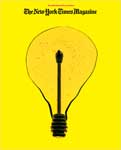SocialPest:
I think you will agree that these art prints Paul Insect produced for this years Santa’s Ghetto are f*cking awesome.
Here.

SocialPest:
I think you will agree that these art prints Paul Insect produced for this years Santa’s Ghetto are f*cking awesome.
Here.

The New York Times Magazine’s Year in Ideas issue is always a fascinating read. A lot of these topics were already posted here on my blog from other news sources as the year went on, but I want to highlight some of my favorites with links to the Magazine:
Bicycle Helmets Put You at Risk
Walker decided to find out — putting his own neck on the line. He rigged his bicycle with an ultrasonic sensor that could detect how close each car was that passed him. Then he hit the roads, alternately riding with a helmet and without for two months, until he had been passed by 2,500 cars. Examining the data, he found that when he wore his helmet, motorists passed by 8.5 centimeters (3.35 inches) closer than when his head was bare. He had increased his risk of an accident by donning safety gear.
When the Phantom Sentinel takes flight, it looks like an awkward boomerang — a set of three small blades. It spins in a circle, faster and faster as it ascends into the sky. Then, when it reaches about 50 feet, it whirls so fast that something remarkable happens: it vanishes right before your very eyes.
Kivetz also interviewed 69 students from Columbia University who had returned one week previously from winter break and found that as a group they were split in roughly equal numbers between regret and contentment for having worked or partied. But when Kivetz talked to alumni who graduated 40 years earlier, the picture was much more lopsided: those who hadn’t partied were bitter with regret, while those who had were now thrilled with their choice. “In the long run,” Kivetz says, “we inevitably regret being virtuous and wish we’d been bigger hedonists.”
On game day, when Pruitt went to the foul line for the first time, Cal students began chanting: “Victoria! Victoria!” and reciting Pruitt’s phone number. Pruitt, a 79 percent free-throw shooter on the season, missed both shots and had one of his worst games of the year, shooting 3 for 13 from the field. Cal won the game by 11 points and went on to the N.C.A.A. tournament.
The next time you see a mother of three head-banging to death metal or a 50-year-old man sporting a faux-hawk, don’t laugh. According to Bruce Charlton, a doctor and psychology professor at Newcastle University in Britain, what looks like immaturity — or in Charlton’s kinder terms, the “retention of youthful attitudes and behaviors into later adulthood” — is actually a valuable developmental characteristic, which he calls psychological neoteny.
The British artist Paul Curtis is not sure what to call his version of vandalism. “People call it ‘reverse graffiti,’ ” he says, “but I prefer something less sinister: ‘clean tagging’ or ‘grime writing.’ ” Curtis, a k a Moose, selectively scrubs dirty, derelict city property (tunnel walls, sidewalks) so that words and images are formed by the cleaned bits. “It’s refacing,” he says, “not defacing. Just restoring a surface to its original state. It’s very temporary. It glows and it twinkles, and then it fades away.”
So you heard from Bill, who heard from Martha in accounting, who heard from Chucky in the mailroom that the company’s plan is to downsize your division right before Christmas, and your head is on the chopping block. Stay calm, right? It’s only a rumor. Well, this is partly true: it is only a rumor. On the other hand, because it’s a rumor, and because it has been passed along by various colleagues, chances are very, very good that you’re doomed.
Full list of 74 ideas Here.

NYT:
“I am facing the most difficult times of my life here in Baghdad. Since I am a Sunni, I became a target to be killed. You know that our army and police are Shia, so every checkpoint represents a serious threat to Sunnis. During the last three weeks, two of my friends were killed at check points belonging to the police. They first asked to show IDs and when they saw the Sunni family name, they killed them.”
There, in plain enough English, you have it. The Iraqi Army and police whose proposed reinforcement lies at the center of the Iraq Study Group’s plan for American extraction are often less neutral institutions supporting the nation than a flimsy camouflage for Shia to settle accounts with Sunnis, while the Kurds bide their time and hope the child of chaos will be an independent Kurdistan.
The Iraqi Army and police are indeed overwhelmingly — but not exclusively — Shia. Most recruitment took place at a time when Sunnis had opted out of the new Iraq. Much has been made of the American error in disbanding Saddam Hussein’s army. More might have been made of the errors committed in creating the new force.
Here.

NYT:
Lately, the major labels have in effect tried to move into the talent management business by demanding that new artists seeking record contracts give their label a cut of concert earnings or T-shirt and merchandise revenue — areas that had once been outside the labels’ bailiwick.
“They’re all starting to ask for the same things,” said Theo Sedlmayr, an entertainment lawyer based in New York who represents acts like 50 Cent.
There has also been a scramble to squeeze revenue from other unconventional sources, including amateur videos posted to YouTube that incorporate copyrighted songs. Universal Music threatened to withhold its huge music catalog from Microsoft’s new digital music service unless it received a royalty of more than $1 on each sale of the technology giant’s Zune portable music player.
Here.

Washington Post:
A few blocks from Ali Farouk’s three-story home, an empty house provides a glimpse of what he fears will be the future. Once owned by a Sunni Muslim, the paint is peeling, the windows are blown out. Two scarlet X’s mark the pale blue front door.
To the door’s right are the words: “Not for Sale. Wanted.”
According to neighbors, “Wanted” refers to the former owner, who fled after crossing paths with the Mahdi Army, the Shiite militia of firebrand cleric Moqtada al-Sadr. The gunmen accused the owner of killing four of their own at a checkpoint. Then they took over his house.
To the door’s left, the words: “This is vengeance for the other day.”
Here.

From VII, photographs by Antonin Kratochvil:
It is estimated that at least one million Africans earn pennies a day in the backbreaking and increasingly fruitless search for diamonds – a $60-billion-a-year industry that, back in the 1990s, rebels in Sierra Leone and Liberia financed their carnage from diamonds plucked out of the rivers and traded for arms. During a decade of war about 50,000 people were killed, and thousands had their hands hacked off by rebels. Now, a new Hollywood movie is raising tough questions about Africa’s bloody diamond trade.
Here.

NYT:
The eight-part series, which begins on Sunday on Showtime and will be shown on consecutive nights, is smart and suspenseful and teeters just this side of seditious. It doesn’t condone jihad or the hate that fuels it, but it tries to show why they hate us, and in doing so goes further than any other post-9/11 drama on American television.
This season goes further afield. The action in the first season was limited mostly to Los Angeles. This time the plot snakes in and around Los Angeles, London, Hamburg, Sarajevo, back alleys in Sudan, palaces in Saudi Arabia and remote desert base camps in Yemen.
It’s a Tom Clancy cloak-and-dagger tale as told by Graham Greene. Terrorists on “Sleeper Cell” are evil, but the United States is neither innocent nor blameless and carries the seed of its own decline. For every act of barbarity by Muslim radicals, and there are plenty — from nuclear Armageddon to the beheading of a female F.B.I. agent on camera — there is a parallel, if not equivalent, blunder by American law enforcement officials and civilians.
Here.

The Moscow Times:
Skinhead leader Ruslan Melnik was sentenced Tuesday by St. Petersburg’s Pushkinsky District Court to 3 1/2 years in prison for his role in the violent group Mad Crowd.
Mad Crowd members have been charged with beating and killing several dark-skinned foreigners.
The district court also found Melnik, 22, guilty of organizing specific attacks, including beatings of Chinese and Armenian citizens and an attack on a McDonald’s restaurant. The verdict said Melnik vandalized McDonalds because he believed it served “Zionist food, which promotes and enforces the American lifestyle.”
Here.

WFMU’s Beware the Blog:
Fans of Andy Kaufman might recall his patented “windmill punch” from his wrestling days, in which he whipped both his arms around non-stop, Pete-Townsend like. He claimed that nobody could touch him while he was “in the punch.”
Hardcore dancing incorporated Andy’s windmill punch into its roster of accepted dance moves long ago, but until I saw this video of the Pennsylvania harcore band cdc doing their song Crowd War, I didn’t realize just how popular the Kaufman influence had become: download mpeg video, 10 megs, or youtube it. (The band cdc is not to be confused with the cult of the dead cow or the center for disease control).
Here.

Blender:
44. MANOWAR
None more metal. None more gay
An American answer to Judas Priest and Iron Maiden, Rochester, New York’s Manowar embody every conceivable heavy-metal cliché: Bodybuilders all, the four wear leather and animal pelts onstage; singer Eric Adams shrieks only of death, warfare and the glory of metal; Joey DeMaio performs solo bass renditions of “The Flight of the Bumblebee.” They’re quite possibly the most ludicrous people in rock & roll history.
Appalling fact In 1993, Russian youth voted Manowar above the Beatles and Michael Jackson as the act they would most like to see perform live.
Worst CD Sign of the Hammer (EMI, 1985)
Here.

Netflix:
Trouble rears its ugly head at the video arcade in this racy 1980s teen comedy about a group of kids who battle a local businessman with plans to shut down the popular hangout. Concerned parent Joe Rutter (Joe Don Baker) believes that video games will destroy the teens’ minds, and when he tries to close down the arcade, it’s up to King Vidiot (Jon Gries), nerdy Eugene (Leif Green) and the rest of the gang to defend their right to play Pac-Man.
Here.

NYT Magazine:
Egypt’s most famous crackdown got under way at a neon floating disco, the Queen Boat, docked on the wealthy Nile-side island of Zamalek, just steps from the famously gay-friendly Marriott Hotel. In the early-morning hours of May 11, 2001, baton-wielding police officers descended upon the boat, where men were dancing and drinking. Security officials rounded up more than 50 of them — doctors, teachers, mechanics. Those who were kept in custody became known among Egyptians as the Queen Boat 52. The detained men were beaten, bound, tortured; some were even subjected to exams to determine whether they had engaged in anal sex. In the weeks that followed, official, opposition and independent newspapers printed the names, addresses and places of work of the detained. Front pages carried the men’s photographs, not always with black bars across their eyes. The press accused the men of sexual excesses, dressing as women, devil worship, even dubious links to Israel. Bakry’s newspaper, Al Osboa, helped lead the charge.
The Queen Boat was just the beginning. Agents of the Department for Protection of Morality, a sort of vice squad within the Ministry of Interior’s national police force, began monitoring suspected gay gathering spots, recruiting informants, luring people into arrest via chat sites on the Internet, tapping phones, raiding homes. Today, arrests and roundups occur throughout the country, from the Nile Delta towns of Damanhour and Tanta to Port Said along the Suez Canal and into Cairo.
Here.
NYT:
“In my view it is time for a major adjustment,” wrote Mr. Rumsfeld, who has been a symbol of a dogged stay-the-course policy. “Clearly, what U.S. forces are currently doing in Iraq is not working well enough or fast enough.”
Nor did Mr. Rumsfeld seem confident that the administration would readily develop an effective alternative. To limit the political fallout from shifting course he suggested the administration consider a campaign to lower public expectations.
“Announce that whatever new approach the U.S. decides on, the U.S. is doing so on a trial basis,” he wrote. “This will give us the ability to readjust and move to another course, if necessary, and therefore not ‘lose.’ ”
“Recast the U.S. military mission and the U.S. goals (how we talk about them) — go minimalist,” he added. Mr. Rumsfeld’s memo suggests frustration with the pace of turning over responsibility to the Iraqi authorities; in fact, the memo calls for examination of ideas that roughly parallel troop withdrawal proposals presented by some of the White House’s sharpest Democratic critics.
Here.
The Observer:
These documents, which form a dossier several inches thick, are the main source for the facts in this article. They suggest that while the eyes of the world have been largely averted, America’s ‘war on drugs’ has moved to a new phase of cynicism and amorality, in which the loss of human life has lost all importance – especially if the victims are Hispanic. The US agencies and officials in this saga – all of which refused to comment, citing pending lawsuits – appear to have thought it more important to get information about drugs trafficking than to stop its perpetrators killing people.
The US media have virtually ignored this story. The Observer is the first newspaper to have spoken to Janet Padilla, and this is the first narrative account to appear in print. The story turns on one extraordinary fact: playing a central role in the House of Death was a US government informant, Guillermo Ramirez Peyro, known as Lalo, who was paid more than $220,000 (£110,000) by US law enforcement bodies to work as a spy inside the Juarez cartel. In August 2003 Lalo bought the quicklime used to dissolve the flesh of the first victim, Mexican lawyer Fernando Reyes, and then helped to kill him; he recorded the murder secretly with a bug supplied by his handlers – agents from the Immigration and Customs Executive (Ice), part of the Department of Homeland Security. That first killing threw the Ice staff in El Paso into a panic. Their informant had helped to commit first-degree murder, and they feared they would have to end his contract and abort the operations for which he was being used. But the Department of Justice told them to proceed.
Here.

Magnum Photos:
For the german magazine “mare”, Gueorgui Pinkhassov travelled to these extreme latitudes eight times. Aboard a mail boat he cruised the Norwegian fjords, visited the Nenets people of Siberia, watched calving glaciers on the east coast of Greenland, and travelled to Canada’s northernmost point. He went to see the Russian Arctic Fleet at Murmansk and accompanied a taxi driver at the European North Cape. Wherever he went, whether it was to visit Norwegian fishermen or Russian submarine soldiers, Pinkhassov always brought back an unexpected view of the Arctic Sea, in the kind of shimmering and radiant impressions of light which are the trademark of his works. A kaleidoscope of light, adventure, awe-inspiring nature and utterly unfamiliar facets of life!
“Nordmeer” has received the German prize: “Best photobook of the Year”.
Here.

PDN:
Most recently, an anonymous bidder paid $2.48 million – with a sense of irony, one hopes – for Gursky’s “99 Cent II Diptychon” (2001), which shows the cluttered interior of a discount store.
The sale, made at a Nov. 16 auction at Phillips de Pury & Company in New York, set an auction record for a work by a living photographer. It fell short of the record for the highest price ever paid for a photo at auction, which was set in February when a 1904 Edward Steichen print sold for $2,928,000.
The work sold at Phillips consists of two chromogenic color prints displayed as a diptych that measures over 22 feet wide. The work is one of an edition of six.
Here.

Wooster Collective:
One of our favorite things about doing the Spring Street project, has been the amazing collection of Stikman images that have been appearing over the last few days on the outside of the building. Sara and I have been fans of Stikman’s work for years, so having him included in the Spring Street project is a great pleasure.
Here.
Joe Reifer:
I’d rather go to the dentist than spend hours scanning negatives. This evening I remembered why I got interested in digital SLRs 5 years ago. I hate scanning. After watching volume 1 of Contacts, I decided to shoot a roll of Tri-X over the Thanksgiving holiday. Even though I own a bunch of fancy SLR gear, I would way rather shoot with a Leica rangefinder. I’m not going to wax poetic about how the Leica M6 is the most perfectly pleasing 35mm camera I’ve ever used, or how the 35mm f/2 ASPH lens has microcontrast and bokeh to die for, I promise. But it’s true.
What I’m going to say is one $4 roll of film, a $12.50 develop and contact sheet, two trips to the lab, and hour and a half of scanning my favorite images later, I remember why I gave this process up. What a pain. Not to mention the cost per shot is about 45 cents (Hey, I’m too lazy to soup my own negs anymore).
Here.